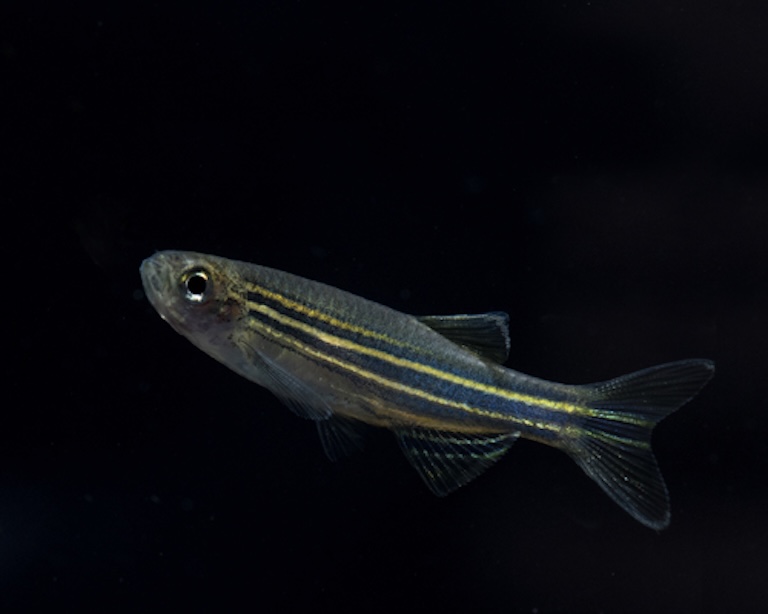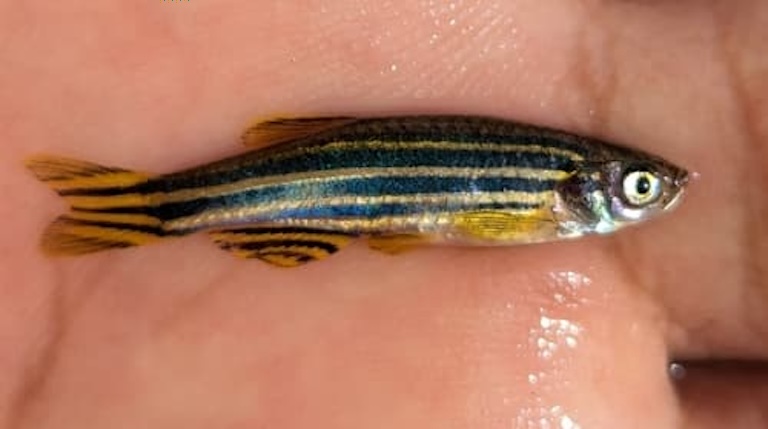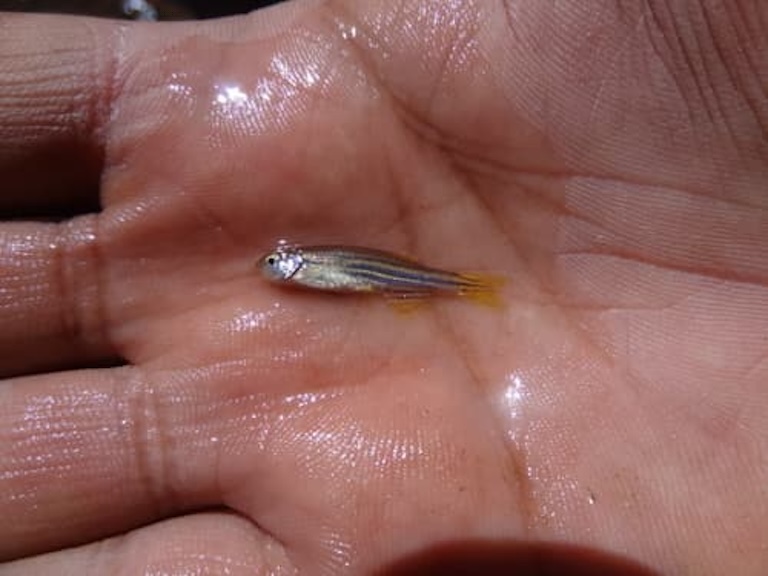Zebrafish Profile
In the freshwater systems Southern Asia, and in the aquaria of hobbyists worldwide, a pretty standard little minnow-like fish had been hiding quite a significant secret.
This fish, a pretty and playful little addition to a fish tank, has been hiding the cure for cancer.

Zebrafish Facts Overview
| Habitat: | Slow flowing streams, rivers, pools and paddies |
| Location: | Native to India, Bangladesh, Nepal, Bhutan, and Pakistan |
| Lifespan: | ~1 year in the wild; typically 2–3 years in captivity (up to ~5 years in ideal conditions) |
| Size: | 4–5 cm (1.6–2.0 in) long |
| Weight: | ~0.2–0.5 g (0.007–0.018 oz) |
| Color: | Metallic gold or silver with bold horizontal blue-black stripes |
| Diet: | Zooplankton and other small crustaceans, aquatic insect larvae |
| Predators: | Larger fish and wading birds |
| Top Speed: | Unknown |
| No. of Species: | 1 |
| Conservation Status: | Least Concern |
Zebrafish are adorable, friendly, playful little freshwater fishes with an unfortunate lot in life. They have a vast amount of resources geneticists are after, and this has led to all kinds of unconscionable acts brought upon them by people looking to advance human medicine.
Some of those tests have led us to the revelation that these intelligent animals are very much conscious, and so there is some hope that as we advance our understanding of non-human sentience – particularly among fish – we get some steps closer to treating our ecological community members with the respect they deserve.
Interesting Zebrafish Facts
1. They’re Minnow-ish
Zebrafish are commonly said to be a type of minnow, but they’re not, really. Minnow is colloquially a term for small freshwater fish, but more officially it refers to the Cyprinidae family in particular, which also includes the carps.
Zebrafish are in the closely-related Daninoinae family, which were once considered a subfamily of minnows, but have more recently been given their own spot next to them.
Most of this family live natively in Asia, but with a few in Africa too.
Within this family, the it’s in the genus Danio that contains the Zebrafish, and is the most popular and well known among collectors and scientists.

2. They’re popular in home aquaria
Zebrafish have a few things going for them that make them popular animals in home aquaria. First off, they’re cute. They have blue and white stripes along their bodies, elegant fins, and they’re small, curious animals with strong personalities.
They exhibit playfulness and hardiness, which makes them relatively easy to keep, though they can be susceptible to infections if they aren’t kept in the rifght conditions.
They also breed quickly, which is where the hobbyist and scientific incentives begin to overlap.
3. They’re transparent
Zebrafish go from egg to larvae in just three days. Breeding this fast means that the effects of gene mutations appear faster, too. And when zebrafish reproduce, their young are transparent. This adds to their appeal as the internal workings of the fish can also be explored without having to cut the poor things open.
And in 2008, geneticists figured out what made these babies transparent and tweaked the genes so that they would remain ghostly into adulthood.
4. They make a lot of embryos
Not only do they breed fast, but they breed a lot, and this means the species can be used to test out an incredible range of concepts.
Some are cute, like the zebrafish that was modified to glow in the dark when it was thinking too hard, and others are downright creepy and cruel, like the fish that are bred with no immune systems at all, or ones that are bred to explore how cancers spread through the body.
Some have been bred to detect oestrogen in water, and can be used to identify oestrogen pollution in lakes. They do this by turning green in the presence of the hormone.
For better or worse, the ability for these fish to produce so many offspring so quickly has rapidly made them one of the most valuable organisms in animal testing.

5. They regenerate limbs
One of the most promising branches of research in medicine relates to regeneration. In many animals, the body produced original, regenerated tissue to replaced damaged parts of the animal, and for some reason in humans, this ability has been mostly turned off.
The very tips of our fingers, and the majority of the liver, are two exceptions of this, and researchers are trying very hard to identify why. Cardiovascular diseases remain the leading cause of death in our species – at least until the antivaxxers roll us back to the dark ages – and this has everything to do with the generation of scar tissue as a weak replacement for real tissue.
If we could crack the genetic puzzle for switching on regeneration, we could restore organs the way many other animals restore them. Animals like the zebrafish.
So, the zebrafish, with its rare ability to regenerate parts of its body, may hold the key to identifying the genes in us that have been switched off.
In fact, the zebrafish heart can be up to 20% removed and recover a brand new and functioning one within two to three months.
And it’s not just the heart. Zebrafish can recover completely from amputated fins, spinal injuries, and all sorts of researcher-inflicted torture. So, the sooner we figure it out, the better it will be for the innocent fish.1
6. They’re model organisms
With all this potential, the zebrafish has instantly become the new highlight of the animal testing world. It showed up in the scientific consciousness as recently as the ‘80s and has since become one of the most important model organisms we have.
Like the fruit fly, they have a lot of genes we share, they breed fast and they’re easy to look after.
Chances are good, a lot of the medicine we, or someone we know, are making use of today owes its production somewhere along the line to the zebrafish or an animal just like it. 2 3
7. They have interesting brains, too
And this makes it all the more upsetting to find out that far from being just a dumb fish, these animals are indeed capable of complex thought.
Zebrafish exhibit episodic memory, showing that they remember where objects are and events happen.
This is one of the key indicators of conscious experience, and points to the fact zebrafish, as inconvenient as it is to science, are quite aware of what’s going on around them.
Ironically, we couldn’t have known this until treating them as computer models, but now that we do, the chances of us stopping are still, sadly, slim.
Zebrafish Fact-File Summary
Scientific Classification
| Kingdom: | Animalia |
| Phylum: | Chordata |
| Class: | Actinopterygii |
| Order: | Cipriniformes |
| Family: | Danionidae |
| Genus: | Danio |
| Species Name: | rerio |
Fact Sources & References
- Gemberling, et al. (2013), “The zebrafish as a model for complex tissue regeneration”, National Library of Medicine.
- (2025), “Zebrafish ”, National Human Genome Research Institute.
- Elizabeth Burke(2016), “Why Use Zebrafish to Study Human Diseases?”, Intramural Research Program.
